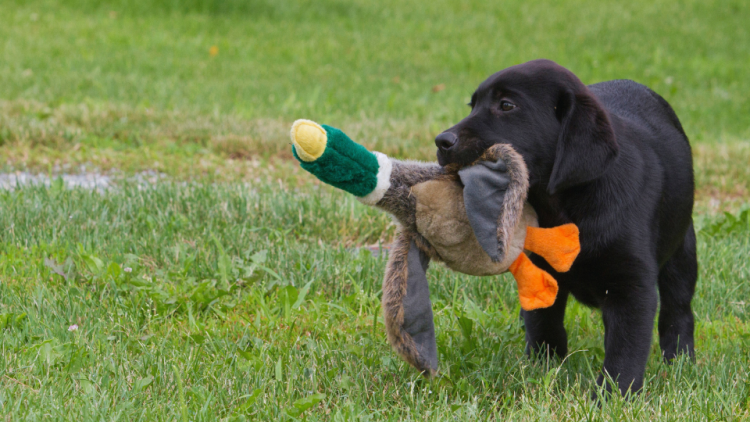How Big Do Black Labs Mixed With Retriver Get
Labrador Retriever Growth & Weight Chart: Everything You Need To Know
As America's most popular dog breed, it should come as no surprise that Labrador Retrievers are affectionate, friendly companions. Labs were originally bred in Newfoundland as duck retrievers and companions to fishermen. English nobles spotted the dogs and brought them home to England, where British breeders continued to refine the breed. Today, Labs are famous for their friendliness and adaptability, as well as being excellent family dogs that are great with children.
If you're the lucky pet parent to one of these sweet-faced dogs, you may be wondering how big will my Labrador Retriever get and when will they stop growing? You can use our Labrador Retriever weight chart to track your pup's development below.
Here's everything you need to know about Labrador Retriever weight, size, and growth rate:
- Labrador Retriever Growth & Weight Chart
- At what age is a Labrador Retriever fully grown?
- How big should a 6-month-old Labrador Retriever be?
- How much bigger will my Labrador Retriever get?
- What is the size of a full-grown Labrador Retriever?
- How do I make sure my Labrador Retriever is healthy?
- Key Takeaways
Pro Tip: New pet parents can get reimbursed for up to 90% of veterinary bills by enrolling in a pet insurance plan. Compare Labrador Retriever health insurance options today to have peace of mind knowing that your Lab has access to gold-standard veterinary care for life.
Labrador Retriever Growth & Weight Chart
| Age | Male Weight | Female Weight |
|---|---|---|
| 1 month old | 3 - 5 lb | 2 - 6 lb |
| 2 months old | 10 - 15 lb | 5 - 10 lb |
| 3 months old | 20 - 30 lb | 20 - 25 lb |
| 4 months old | 30 - 40 lb | 25 - 35 lb |
| 5 months old | 35 - 45 lb | 30 - 40 lb |
| 6 months old | 40 - 55 lb | 35 - 45 lb |
| 7 months old | 50 - 60 lb | 40 - 50 lb |
| 8 months old | 50 - 65 lb | 40 - 55 lb |
| 9 months old | 55 - 70 lb | 45 - 60 lb |
| 10 months old | 55 - 70 lb | 50 - 60 lb |
| 11 months old | 60 - 75 lb | 55 - 65 lb |
| 12 months old | 65 - 80 lb | 55 - 70 lb |
| 2 years old | 65 - 80 lb | 55 - 70 lb |
Please keep in mind that the above numbers are estimates of the average Labrador Retriever weight by age. If your pup is ahead or behind these figures, don't worry! All dogs are unique and grow at their own rate. Continue taking your Lab to regular veterinary appointments and discuss any concerns you may have about your puppy's health with your veterinarian.
At what age is a Labrador Retriever fully grown?
As medium- to large-sized dogs, Labrador Retrievers require a little more time to fill out than smaller breeds. Labs need at least a year to reach their full size, but pups with bigger bone structures may require up to 18 months to fill out their chest. As a rule of thumb, your Lab should be at or close to their full size by their first birthday.
How big should a 6-month-old Labrador Retriever be?
A male six-month-old Labrador weighs roughly 40 to 55 pounds. Comparatively, female Labs will weigh slightly less at 35 to 45 pounds around six months of age. Please keep in mind that these numbers are averages, and every puppy will grow at a slightly different rate.
Pro Tip: Download this new puppy checklist detailing how to set up a vaccination schedule, wellness plan, microchips, things to have on hand for your puppy, and more.

How much bigger will my Labrador Retriever get?
There are three ways to predict the size of a Labrador Retriever at maturity:
- Age. Labrador Retrievers typically reach their full height and weight around their first birthday. Larger Labs may need up to 18 months to fill out their chest, but any weight gain after 12 months should be minimal overall. If your Lab is less than a year old, they are likely still growing and putting on muscle to reach their adult size.
- Paw Size. You can also take a look at your Labrador Retriever's paws. If their paws look oversized next to their legs and body, then they are probably still growing, as this is a classic puppy feature.
- Genetics. Lastly, if you purchased your Lab through a breeder, you can contact them for a more exact height and weight estimate. Your breeder can provide you with your puppy's parents' height and weight, along with the adult sizes of previous litters to give you an idea of your puppy's final size.
What is the size of a full-grown Labrador Retriever?
A Labrador Retriever should weigh between 65 and 80 pounds and stand about 22.5 to 24.5 inches tall as a mature male, according to the American Kennel Club Official Labrador Retriever Breed Standards. In contrast, a female Labrador Retriever should weigh about 55 to 70 pounds and stand at 21.5 to 23.5 inches tall. Make sure to consult with your veterinarian to ensure that your Lab is maintaining a healthy weight for their body size.
The weight of a Labrador Retrievers should be indicative of its athletic body and muscular build. They are longer than they are tall, with a large, tapering tail (known as an "otter tail") initially bred by design to serve as a strong rudder that aided Labs when swimming to retrieve ducks.

How do I make sure my Labrador Retriever is healthy?
Labrador Retrievers are known as America's sweetheart dog breed and for good reason. Between their friendly demeanor, adaptability, and outgoing disposition, they make ideal family members.
As cherished members of our families, our Labs deserve the best care. Unfortunately, like many other purebred dogs, Labrador Retrievers are more susceptible to various health issues. This can be heartbreaking to think about as loving pet parents. However, prevention can go a long way in preventing and minimizing future health problems.
In particular, hip dysplasia, degenerative joint disease (arthritis), allergic skin disease, bloat, and some types of cancer are common health concerns for Labs. They can quickly become overweight or obese if they are overfed or under-exercised, contributing to or exacerbating many joint diseases. Additionally, these dogs can be mischievous, especially as puppies, and may ingest foreign items such as clothing, toys, and other items around the house that can lead to the need for emergency veterinary care.
Routine veterinary care gives your veterinarian the chance to regularly screen your Lab for diseases, monitor their weight, assess their current health, and give you personalized recommendations to keep your pup happy and healthy.
Labrador Retriever Veterinary Costs
When surveyed, only 19.44% of pet parents said they'd be able to pay for a $5,000 veterinary expense out-of-pocket, which leaves many pet parents in a pinch should their loved one need treatment, especially in an emergency. For example, your Labrador Retriever may need treatment for a cruciate ligament tears, which are common in Labs. A healthy cruciate ligament supports the knee joint but can tear due to genetic predisposition, obesity, injury, or other causes.
According to Hopkinton Animal Hospital, cruciate ligament tear surgery typically costs between $3,500 and $5,500. Without treatment, a dog can experience pain, limping, and develop significant arthritis. With treatment, the prognosis is favorable, and many dogs can return to their normal activities post-recovery.
Pet insurance works by reimbursing you for up to 90% of out-of-pocket veterinary costs, like surgery, hospitalization, lab work, and diagnostic services. When your Lab has a pet insurance policy, they are covered for new injuries, illnesses, and emergencies that may arise. Pet insurance allows you to focus on what's important: your Lab's health and happiness. Pet insurance offers you and your veterinarian the chance to focus on getting your pup the best treatment rather than worrying about the finances.
Key Takeaways
- Our Labrador Retriever weight chart predicts the growth of your puppy until they stop growing between 12 to 18 months old.
- Official American Kennel Club standards state that female Labs should weigh between 55 and 70 pounds, while male Labs should weigh between 65 and 80 pounds.
- Labrador Retrievers are more prone to a variety of hereditary and acquired conditions.
- Pet insurance can protect your Lab and provide a financial safety net for unexpected veterinary expenses throughout their life.
How Big Do Black Labs Mixed With Retriver Get
Source: https://www.pawlicy.com/blog/labrador-retriever-growth-and-weight-chart/